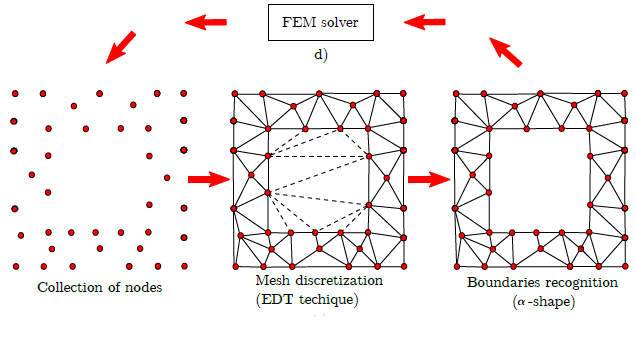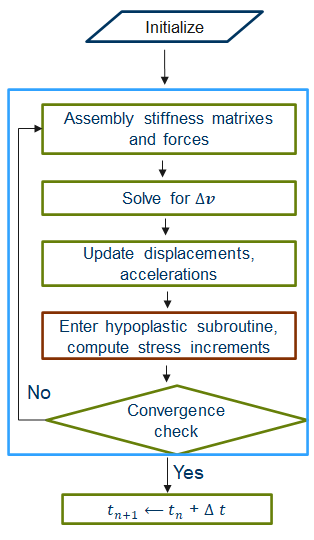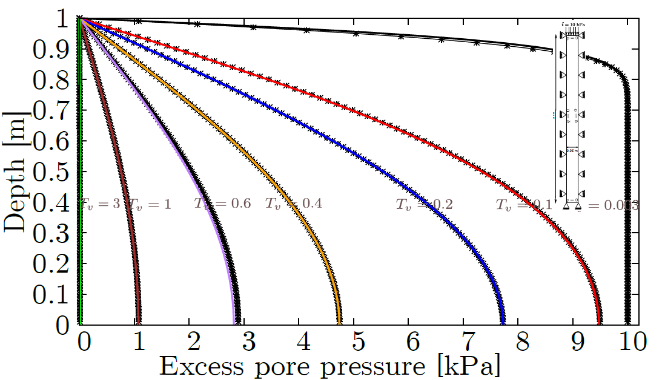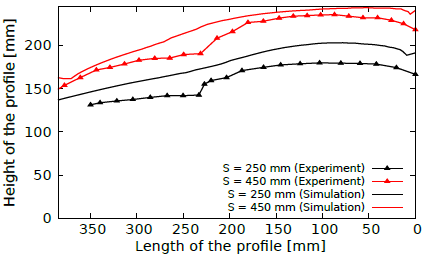Mechanized excavations of soft soils, such as those performed in tunneling by means of Tunnel Boring Machines (TBM), earth tillage and mining operations, are characterized by large deformations of the material, the spatio-temporal evolution of the ground free surface and the boundaries of the excavation. Furthermore, the soft soil exhibits a strong non-linear constitutive behavior during the excavation processes.
Numerical methods are suitable for the detailed investigation of the soft soil behavior, allowing for the analysis of the soil deformations and stresses, pore pressures (when interstitial water is present) and reaction forces exerted on the excavation tool. In this research, a robust computational strategy based on the Particle Finite Elements Method (PFEM) [1] combined with a hypoplastic constitutive model [2] is proposed in [3,4]. Experiments developed at the Ruhr-University Bochum supporting the capabilities of the method, are presented in [5]. Figure 1 - left) presents the PFEM remeshing strategy and Figure 1 - right) shows the algorithm of the proposed computational strategy in [3].


Results of the computational analyses of single and multiple cutting tools excavating in soft soils are presented below in Figure 2. The left and center subfigures, show the total velocity distribution of the particles, considering single and multiple cutting tools, respectively. Figure 2 (right) displays the spatio-temporal evolution of reaction forces computed on a single cutting tool.
Finally, a two-phase PFEM hypoplastic model has been developed for the analyses of mechanized excavations in partially and fully saturated conditions. Figure 3 (left) shows the water pore pressure profiles over the depth of a soil column after re-analysis of a consolidation test. Figure 3 (right) shows the topology of the excavation profile for selected tool displacements.



References
- [1] Oñate, E., Idelsohn, S. R., Del Pin, F., & Aubry, R. (2004). The particle finite element method — an overview. International Journal of Computational Methods,1(02), 267-307.
- [2] Von Wolffersdorff, P. A. (1996). A hypoplastic relation for granular materials with a predefined limit statesurface. Mechanics of Cohesive‐frictional Materials: An International Journal on Experiments, Modelling and Computation of Materials and Structures,1(3), 251-271.
- [3] Bal, A. R. L., Dang, T. S., & Meschke, G. (2020). A 3D particle finite element model for the simulation ofsoft soil excavation using hypoplasticity. Computational Particle Mechanics,7(1), 151-172.
- [4] Bal, A. R. L., & Meschke, G. (2020). A particle finite element model for the simulation of mechanized excavations in unsaturated soft soils. In preparation[5] Bal, A. R. L., Hoppe, U., Dang, T. S., Hackl, K., & Meschke, G. (2018). Hypoplastic particle finite element model for cutting tool-soil interaction simulations: Numerical analysis and experimental validation. Underground Space,3(1), 61-71.
Contact
M.Sc. Abdiel Leon Bal
Abdiel.LeonBal@rub.de
+49 234 / 32-27792